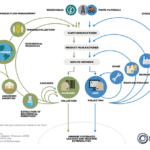
In the fast-paced world we live in, where technology is constantly evolving, it is not surprising that education is also undergoing a revolution.
The power of educational innovation is transforming traditional classrooms into dynamic learning environments, where students are encouraged to think critically, collaborate with their peers, and actively participate in their own learning journeys.
This revolution is not just about incorporating technology into classrooms; it is about reinventing the entire educational experience. From personalized learning platforms that cater to individual student needs to virtual reality simulations that bring history and science to life, educational innovation is opening up a world of possibilities for both students and educators.
But what is educational innovation? If you are a teacher, student, or researcher, in this article, we want to provide you with some basic concepts that can help you on your journey to implementing innovation in your educational practices.
On the path to the knowledge society
As you are already aware, the world is transitioning from an industrial society to a knowledge society; however, in this new scenario, advances in education and research will have a significant contribution to solving the problems affecting the population and, therefore, society as a whole.
The COVID-19 pandemic has highlighted the fundamental importance of research, innovation, and development in addressing current and future challenges as a society. Above all, it has emphasized the role of innovation in adapting to a changing world.
As you know, human capital is an important aspect of a knowledge society, and consequently, economic development. It directly affects development, for example, by increasing labor productivity, and indirectly through fostering innovation.
Therefore, the new knowledge society requires innovative and entrepreneurial individuals, and as a teacher, you hold the future in your hands.
Regarding this, Newman et al. (2020) report that an increase in human capital can promote the number of entrepreneurs and innovative products; incentivizing investment in the adoption and creation of technology.
Likewise, researchers like Mykhailyshyn et al. (2018) emphasize that the limits of modern civilization’s growth are determined by education, its quality, and accessibility. Thus, innovation plays a significant role in current educational systems.
The importance of educational innovation
Education is the foundation of society, providing people with the knowledge and skills they need to succeed in life. However, traditional educational systems have often been criticized for their one-size-fits-all approach, where students are expected to learn at the same pace and in the same way. This is where educational innovation comes into play.
By adopting educational innovation, we can create a more personalized and inclusive learning experience that meets the diverse needs of students.
Educational innovation goes beyond simply incorporating new technologies into classrooms. It is about reinventing how we teach and learn, adopting new pedagogical approaches, and fostering a culture of creativity and curiosity.
The educational innovation approach encourages students to become active participants in their own learning, rather than passive recipients of information. By empowering students to take ownership of their learning, educational innovation cultivates critical thinking, problem-solving, and collaboration skills—essential skills for success in the 21st century.
How to foster innovative individuals?
Finding an answer to this important question is strategic for preparing a society for the changes and challenges of the knowledge society. However, how innovative are our educational systems?
I believe there is not much to think about to find an answer. Our educational system maintains a product-focused approach, where all students are provided with the same content and expected to achieve the same competencies, regardless of their diverse vocations and learning styles.
Current traditional educational systems fail to develop the innovative individuals needed in the knowledge society. Therefore, promoting innovation in education is crucial as it plays a crucial role in creating a sustainable future.
Many times we perceive education as a sector resistant to change, and if changes occur, they are implemented slowly. However, as explained earlier, the educational sector is a crucial piece if we want to promote the development, economic growth, and well-being of a country.
Educational systems that change people
Researchers Fındıkoğlu and İlhan (2016) emphasize that educational systems change people and their societies, and vice versa. We can consider this as a virtuous circle, if applied well, and in which educational innovation plays a leading role.
In this regard, UNESCO (2016) highlights that education is central to the formation of a culture of innovation, where the focus is on making this activity a culture and not just a trend.
As explained by OECD (2016), innovation can help improve the quality of education and that educational innovation is imperative to achieve qualitative changes, in contrast to mere quantitative expansion, leading to greater efficiency and better results in the quality and equity of learning opportunities.
Theory of innovation in education
We must start from the understanding that “innovation in education” is a broader concept than “educational innovation.” The former term refers to how we promote innovation in the education sector, while “educational innovation” focuses on innovative practices within the educational sector.
Pacheco (2020) highlights that innovation is a permanent, original, and intentional process of seeking improvement in educational quality and student learning. As described by Murillo (2017), the definition of educational innovation implies the implementation of significant changes in the teaching-learning process, encompassing various aspects: technology, didactics, pedagogy, processes, and people.
On the other hand, Serdyukov (2017) indicates that in education, innovation can appear as a new pedagogical theory, methodological approach, teaching technique, instructional tool, learning process, or institutional structure, which, when implemented, brings about a significant change in teaching and learning, leading to better student learning.
To analyze the theory of innovation in education, we must cite Stukalenko et al. (2014), who emphasize that in education, there are two types of innovative phenomena: pedagogical innovation theory (innovations in the educational system) and innovations in learning.
Pedagogical innovation: related to restructuring and modifying, improving, and changing the educational system or its parts separately, characteristics, and aspects.
Innovation in learning: defined as a specific type of mastering knowledge and as a product of conscious, goal-oriented, and scientifically-based activity in the educational process.
What is educational innovation?
At this point in the article, you already have information about the theories of innovation in education, how innovation can add value to the educational sector, among other aspects, but we still need to define educational innovation.
According to UNESCO (2014), “educational innovation is a deliberate and planned act of problem-solving aimed at achieving higher quality in student learning, going beyond the traditional paradigm. It involves transcending academic knowledge and moving from passive student learning to a conception where learning is interaction and is built among everyone.”
On the other hand, OECD/CERI (2010) defines educational innovation as “… any dynamic change that seeks to add value to the educational process and results in measurable outcomes in terms of satisfaction of those involved or educational performance.”
Margalef et al. (2006) highlight that the concept of innovation in education must be understood based on the following characteristics:
- It involves an idea perceived as novel by someone and includes the acceptance of such novelty.
- It implies a change that seeks to improve an educational practice.
- It is a deliberate and planned effort aimed at the qualitative improvement of educational processes.
- It entails learning for those actively involved in the innovation process.
- It is related to economic, social, and ideological interests that influence any innovation process.
Finally, Mykhailyshyn et al. (2018) highlight that educational innovations include:
- Pedagogical innovation: the change of style in teaching and the organization of the educational process; the introduction of innovative education models; the nature of the teacher’s interaction with students and their positions in the learning processes; effective organization of the educational process, particularly in the use of modern information and communication technologies.
- Scientific and methodological innovation: updating the content of educational programs according to their best local or international counterparts; introducing innovative courses; creating modern content for teaching materials.
- Educational and technological innovation: the use of new or improved learning technologies (e.g., distance or online education); providing students and teachers with access to electronic libraries.
In this regard, we can conclude that educational innovation can be defined as the process of introducing new ideas, tools, and strategies to transform the educational experience. It is about challenging the status quo and finding new ways to engage students, improve learning outcomes, and prepare them for the future.
Education to promote innovation
You must be overwhelmed with definitions and concepts, the question to answer now is, how do we promote innovation through education? There are many recommendations in this regard; however, Newman et al. (2020) compiled a report studying how education can contribute to a more innovative society.
The researchers provide five recommendations for countries looking to ensure that education is driving innovation:
- Focus first on basic skills.
- Change teaching practices to develop innovative capabilities.
- Optimize the skill mix.
- Promote quality research.
- Catalyze innovation through a mix of skills and create conducive environments.
Furthermore, it is important to emphasize that educational innovation must help promote creativity in students.
The impact of educational innovation on student learning
Educational innovation has a profound impact on student learning outcomes. By personalizing the learning experience, educational innovation ensures that students receive the support and resources they need to succeed. This leads to greater engagement, motivation, and student performance. When students actively participate in their learning, they become more engaged in their educational journey, leading to improved learning outcomes.
Moreover, educational innovation fosters the development of critical thinking, problem-solving, and collaboration skills—essential skills for success both in academic settings and in the workplace.
By adopting innovative teaching methods and pedagogies, educators can create a learning environment that encourages students to think critically, analyze information, and work collaboratively with their peers. These skills are not only crucial for academic success but also for success in the workforce and life.
How to innovate in the classroom?
Finally, as a teacher, you must be interested in promoting innovation in the classroom. In this regard, Pacheco (2020) identifies seven fundamental keys to promoting and implementing innovation in classrooms:
The quality of teachers is crucial. It requires teachers with sensitivity, commitment, consistency, creativity, empathy, and the ability to motivate and excite students.
Changes in school management. It requires pedagogical leadership that is inclusive, distributed, and not adult-centric, capable of generating and maintaining a culture of innovation in the educational institution.
Innovating involves a radical transformation of the educational model. It is necessary to unlearn the model centered on information, memorization, and verticality, and build models focused on active methodologies, learning to learn, self-regulated learning, and collaborative work.
Diversity is another fundamental pillar for innovation and an opportunity for learning.
Reclaiming slowness as a pedagogical necessity. Every learning process requires time for it to be meaningful, deep, and lasting.
Innovating is building citizenship. The key to education is the formation of citizens capable of relating with mutual respect and appreciation of human rights.
Educational innovation is what starts now and is assumed as a sustained practice over time, with a focus always on improving student learning outcomes.
Challenges and Barriers to Educational Innovation
While educational innovation has enormous potential, it is not without challenges and barriers. One of the main challenges is resistance to change. Traditional educational systems have been around for decades, and changing how we teach and learn can generate skepticism and resistance. Educators, administrators, and policymakers may hesitate to adopt new ideas and strategies, fearing they may disrupt established routines and structures.
Another challenge is the digital divide. While technology has become increasingly prevalent in classrooms, not all students have equal access to technology and the Internet. This digital divide creates disparities in educational opportunities, as students from disadvantaged environments may not have the same access to online resources and tools. Closing the digital divide is crucial to ensuring that all students have equal opportunities to benefit from educational innovation.
The future of educational innovation
The future of educational innovation is bright and full of possibilities. As technology continues to advance, we can expect to see even more innovative tools and strategies that enhance the learning experience. Virtual reality, augmented reality, artificial intelligence, and machine learning are just some of the technologies that promise to revolutionize education.
Moreover, educational innovation is not limited to the classroom. It extends beyond formal education to lifelong learning and professional development. As the job market evolves, continuous learning and skills improvement will be essential. Educational innovation will play a crucial role in providing people with the skills they need to adapt to the ever-changing demands of the future.
Conclusion
Educational innovation has the power to transform education and unlock the true potential of each student. By adopting innovative ideas, tools, and strategies, we can create a more personalized, inclusive, and engaging learning experience.
In this sense, implementing innovation in education is an important element to promote educational innovation, allowing us to have innovative and entrepreneurial individuals to face the challenges of the knowledge society.
Educational innovation is allowing an educational tools industry to emerge (Foray and Raffo, 2014), driving new spaces for knowledge generation and accumulation. This will increasingly encourage more innovations in the educational sector.
As educators, administrators, policymakers, and students, it is our collective responsibility to embrace educational innovation and pave the way for a brighter and more inclusive future.
If you liked this article, please share it with your colleagues and friends. It will help us grow our followers and provide you with more information. We leave you this video to understand the importance of education and how it changes people’s lives.
References
Findikoglu F. and Dilek Ilhan. 2016. Realization of a Desired Future: Innovation in Education. Universal Journal of Educational Research 4(11): 2574-2580.
Foray D. and J. Raffo. 2014. The Emergence of An Educational Tool Industry: Opportunities and Challenges For Innovation in Education. Economic Research Working Paper No. 19. WIPO. 23
MARGALEF GARCÍA, LEONOR, ARENAS MARTIJA, ANDONI ¿QUÉ ENTENDEMOS POR INNOVACIÓN EDUCATIVA? A PRÓPOSITO DEL DESARROLLO CURRICULAR. Perspectiva Educacional, Formación de Profesores [en linea]. 2006, (47), 13-31[fecha de Consulta 16 de Octubre de 2020]. ISSN: 0716-0488
Mykhailyshyn Halyna, Kondur Oksana & Serman Lesia. (2018). Innovation of Education and Educational Innovations in Conditions of Modern Higher Education Institution. Journal of Vasyl Stefanyk Precarpathian National University. 5. 10.15330/jpnu.5.1.9-16.
Murillo A. 2017. ¿Qué es innovación educativa?
Newman K., Elisabetta Gentile, and Nina Ashley Dela Cruz. 2020. Education for Innovation: Sorting Fact from Fiction. 74 p.
OECD/CERI. (2010). Inspired by Technology, Driven by Pedagogy: A Systemic Approach to Technology-based School Innovation, Educational research and Innovation. OECD Publishing.
OECD (2016), Innovating Education and Educating for Innovation: The Power of Digital Technologies and Skills, OECD Publishing, Paris. 153 p.
http://dx.doi.org/10.1787/9789264265097-en
Pacheco B. 2020. Siete claves para la innovación educativa. El País.
Serdyukov, P. (2017), “Innovation in education: what works, what doesn’t, and what to do about it?”, Journal of Research in Innovative Teaching & Learning, Vol. 10 No. 1, pp. 4-33. https://doi.org/10.1108/JRIT-10-2016-0007
Stukalenko Nina, Bariya B. Zhakhina, Asiya K. Kukubaeva, Nurgul K. Smagulova, Gulden K. Kazhibaeva. 2016. Studying innovation technologies in modern education. INTERNATIONAL JOURNAL OF ENVIRONMENTAL & SCIENCE EDUCATION, 2016, VOL. 11, NO. 14, 6612-6617.
UNESCO. 2016. Texto 1: Innovación educativa. Serie “Herramientas de apoyo para el trabajo docente”. 52 p.





